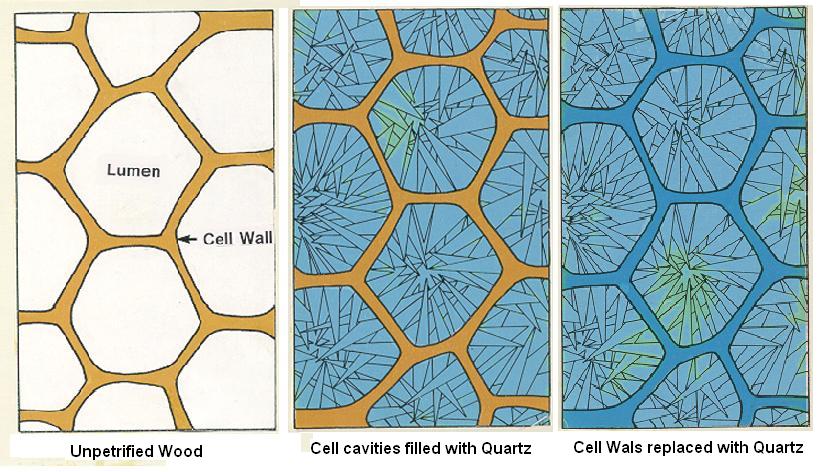
 There is a paved pathway up to the fenced petrified tree
and some educational panels at the parking lot.
There is a paved pathway up to the fenced petrified tree
and some educational panels at the parking lot.
This is the last of at least 3 upright petrified trees that were
in the area. The other trees and any surrounding pieces of
petrified trees have been carted away by collectors. Collecting any
specimens or defacing natural resources is prohibited in the park
and strictly enforced.
This redwood and its missing neighbors grew on the slopes of
mountains near a volcano. When these volcanoes erupted they caused
large landsides, mudslides, and mudflows that covered the forests
of the area. The aftermath of the eruption has been compared to the
forests near Mount St. Helens in 1980.
Large areas of forest were blown down. The boulders, mud,
sediment, and foliage were concentrated in river valleys, filling
them up. In other areas a variety of tree species, leaves, pollen,
and other fossils can be found. Later eruptions and floods buried
this jumble of material and the petrifaction began.
 Water percolating down through the soils of
the area dissolved silica and calcite from the volcanic ash
that buried the trees. This water transported the silica and
calcite into the cells of the wood depositing the minerals in
the wood. Usually the petrification process continues to
replace the cell walls and all organic material with silica as
shown in the diagram, but here the petrifaction process
preserved the actual organic wood material. Scientists have
dissolved the minerals from specimens using hydrochloric acid
allowing them to study the organic material.
Water percolating down through the soils of
the area dissolved silica and calcite from the volcanic ash
that buried the trees. This water transported the silica and
calcite into the cells of the wood depositing the minerals in
the wood. Usually the petrification process continues to
replace the cell walls and all organic material with silica as
shown in the diagram, but here the petrifaction process
preserved the actual organic wood material. Scientists have
dissolved the minerals from specimens using hydrochloric acid
allowing them to study the organic material.
Through their study, scientists have identified over 200 species
of plants that have been fossilized in the area. These include cool
climate trees such as spruce, fir, alder, and willow next to war
climate trees such as magnolia, avocado, and laurel along with
intermediate climate species such as sycamore, walnut, oak, and
hickory.
This wide range of species is explained by a wide range of
elevations in the prehistoric mountain range provided. Following
the eruption, the cool climate species were transported down the
mountains and came to rest near the warm climate species.
Logging requirements:
Send me a note with :
- The text "GC14YVK Yellowstone Petrified Tree" on the first
line
- The number of people in your group.
- When was this tree alive and when did it get buried?
- Compare that age to the most recent Yellowstone eruption (not
on the panel)
- What modern-day species is this specimen compared to
The above information was compiled from the
following sources:
- NPS informational Pannel
- Fritz, William J., Roadside Geology of the
Yellowstone Country, Mountain Press Publishing Company, May
1989.
- The Process of Petrification,
http://www.geocities.com/Yosemite/Campground/5660/palette.html
Placement approved by the
Yellowstone National Park